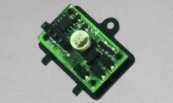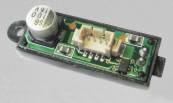Digital Scalextric cars that drive at full speed with no control
Reasons why your digital Scalextric car drives at full speed when the throttle is at zero speed
The Scalextric Digital system uses frequent digital data messages from the controller to a microprocessor fitted to the car. The track has a permanent A.C. power supply which also goes to the microprocessor in the car. The microprocessor in the car then controls a Pulse Width Modulated (PWM) power feed to the motor based on the digital data messages from the controller. Therefore there is no direct connection from the track to the motor in a digital car.
In order for your digital Scalextric car to move forwards the Pulse Width Modulated (PWM) power feed to the motor is switched by small silicon based transistors mounted on the digital chip inside the car. These transistors follow the low current signal from the microprocessor and provide the high current needed by the Scalextric motor.
The microprocessor fitted to the car acts like a little soldier in that it will obey the last command received in the absence of any new commands.
So why would a digital Scalextric car drive off at full speed when placed on the track which has no throttle input?
1. The first possible fault is that the data communications from the controller to the microprocessor fitted to the car is interrupted. The most likely cause of this would be dirty or worn pick up braids. There's a good enough connection for the permanent A.C. power supply to reach the digital chip but too much interference from the poor connection to the track for the data signals to reach the digital chip.
The solution is new braids, clean the track and maybe give the car a service.
2. The second possible fault is that the microprocessor has a problem, software lock up or damaged silicon. Either way the Pulse Width Modulated (PWM) signal from the microprocessor to the output transistors is telling the transistors to drive the car at full speed.
If the software is the problem then maybe, just maybe leaving the car with no power for 30 minutes will clear the fault. If this doesn't work then a replacement digital chip is the only solution.
3. The third possible fault is that the output transistors on the digital chip are damaged and are driving the motor at full speed even though the Pulse Width Modulated (PWM) signal from the microprocessor is correct.
The solution here is a replacement digital chip once the motor has been checked for health (see fault 4).
4. The fourth possible fault is that the output transistors on the digital chip have been damaged by a fault in the motor. The motor fails and consumes too much electrical current from the output transistors, the transistors overheat and, well, simply melt to form a short circuit between the power feed and the motor.
The solution here is a replacement digital chip once the motor has been checked for health.
As you can see there are very few reasons why a digital Scalextric would car drive off at full speed when placed on the track which has no throttle input. There are even fewer repair options. Contact us if you need any further assistance.
View the range of parts we have available
This great maintenance guide is brought to you by Scalextric Car Restorations at:



